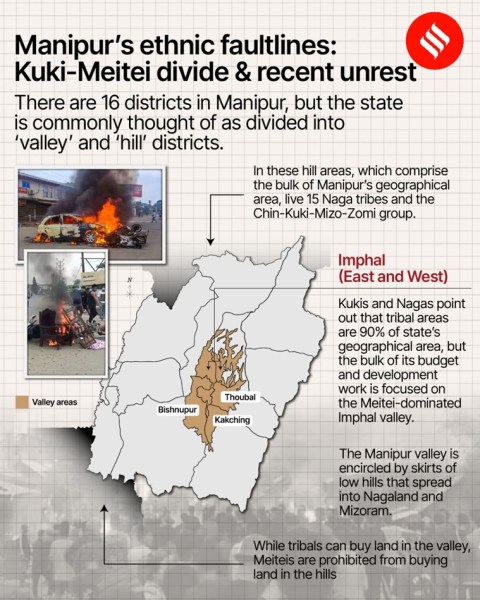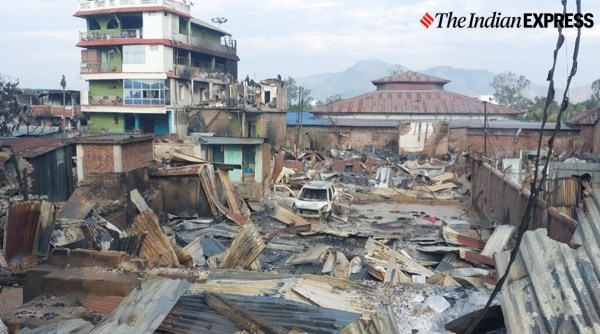Manipur’s ethnic faultlines: Kuki-Meitei divide & recent unrest
Kukis and Nagas point out that tribal areas are 90% of state’s geographical area, but the bulk of its budget and development work is focused on the Meitei-dominated Imphal valley. Each of these groups has its aspirations and insecurities, and old grievances have been triggered by new developments
 People from Manipur raise slogans during their protest against the ongoing violence in Manipur, at Manipuri Rajbari in Guwahati, Friday, May 5, 2023. (PTI Photo)
People from Manipur raise slogans during their protest against the ongoing violence in Manipur, at Manipuri Rajbari in Guwahati, Friday, May 5, 2023. (PTI Photo) Manipur is no stranger to violent protests, but the ongoing violence between the Kuki-Zomi tribals and the largely Hindu Meiteis is the first time in three decades that the state has witnessed direct clashes between two ethnic groups. In 1993, Hindu Meiteis clashed with Pangals (Muslims), and there was horrific violence involving the tribal Nagas and Kukis, which saw more than a hundred Kukis massacred in a single day, and thousands driven from their homes.
Cultural geography
 There are 16 districts in Manipur.
There are 16 districts in Manipur.
There are 16 districts in Manipur, but the state is commonly thought of as divided into ‘valley’ and ‘hill’ districts. Today’s valley districts of Imphal East, Imphal West, Thoubal, Bishnupur, and Kakching were part of the erstwhile kingdom of Kangleipak, ruled by the Ningthouja dynasty. Many historians and academics say the tribal areas outside the valley were also part of the kingdom, but this is disputed by the tribes, in particular the Naga tribes.
The Manipur valley is encircled by skirts of low hills that spread into Nagaland and Mizoram. In these hill areas, which comprise the bulk of Manipur’s geographical area, live 15 Naga tribes and the Chin-Kuki-Mizo-Zomi group, which includes the Kuki, Thadou, Hmar, Paite, Vaiphei and Zou peoples.
The Kangleipak kingdom, then a British protectorate, was repeatedly raided by Naga tribes who came down from the northern hills. The British political agent in Manipur is believed to have brought the Kuki-Zomi from the Kuki-Chin hills of Burma to protect the valley from plunder by acting as a buffer between the Meiteis and the Nagas.
 Meiteis protest against the ongoing clashes in Manipur, at Jantar Mantar in New Delhi on Friday. The Northeastern state has seen widespread violence over the past couple of days. PTI
Meiteis protest against the ongoing clashes in Manipur, at Jantar Mantar in New Delhi on Friday. The Northeastern state has seen widespread violence over the past couple of days. PTI
The Kukis, like the Nagas, were fierce headhunting warriors — and the Maharaja gave them land along the ridges, where they could act as a shield for the Imphal valley below.
Kuki-Meitei divide
Ethnic tensions between the hill communities and the Meiteis have existed from the time of the erstwhile kingdom, but the friction started escalating with the advent of the Naga national movement in the 1950s, and the call for an independent Naga nation. The Naga insurgency was countered by the rise of insurgent groups among the Meiteis and Kuki-Zomi.
In the 1990s, as the NSCN-IM pushed harder for self-determination, the Kuki-Zomi groups began to militarise, and the Kukis launched their own movement for ‘Kukiland’ — unlike the Naga movement, however, the Kuki-Zomi demand was for a state within India, not a separate national homeland. Even though the Kukis had started out as protectors of the Meitei people, the Kukiland demand created a rift between the communities.
 Vehicles in flames after violence broke out during the ‘Tribal Solidarity March’ called by All Tribal Student Union Manipur (ATSUM), in Imphal, Thursday, May 4, 2023. (PTI Photo)
Vehicles in flames after violence broke out during the ‘Tribal Solidarity March’ called by All Tribal Student Union Manipur (ATSUM), in Imphal, Thursday, May 4, 2023. (PTI Photo)
During the Naga-Kuki clashes of 1993, NSCN-IM cadres allegedly went from village to village in areas they claimed as belonging to Nagas, emptying them of Kuki residents. Many Kukis fled to Churachandpur, a district dominated by the Kuki-Zomi people. Analysts have pointed out that the cornering of Kukis in one district (although pockets of Kukis villages can be found in other parts of Manipur as well), increased their sense of insecurity.
Meitei fears
The Naga and Kuki movements fuelled Meitei nationalism, and numerous groups sprung up in the valley. Concerns over demographic change and shrinking of traditional Meitei areas started to surface in the 1970s. There were some demands for Scheduled Tribe status for Meiteis, but the discourse remained largely muted.
In 2001, the Indian government’s decision to extend its ceasefire with the IM to states other than Nagaland led to widespread violence in Manipur. In Imphal, protesters set the Assembly building on fire. The demand for ST status became a mass movement from this point onward, as an increasingly insecure Meitei population feared the possible creation of Greater Nagalim would lead to shrinking of Manipur’s geographical area.
 Destruction raged throughout Haokip Veng as ethnic violence rocked Manipur over the last 3 days. (Express Photo: Jimmy Leivon)
Destruction raged throughout Haokip Veng as ethnic violence rocked Manipur over the last 3 days. (Express Photo: Jimmy Leivon)
During the period 2006-12 came the demand for an Inner Line Permit (ILP) in Manipur, which would bar outsiders from entering the state without permission. The free movement of the Kuki-Zomi across Manipur’s porous border with Myanmar — communities belonging to this group of tribes are bound by strong links of ethnicity, customs, language, and dress, and often see themselves as a fluid population living uncircumscribed by boundaries of country and state — fanned fears of demographic change.
The Federation of Regional Indigenous Societies, which spearheaded the ILP demand in 2006, claimed that the growth rate of Manipur’s population had jumped from 12.8% in the 1941-51 period to 35.04% during 1951-61 and to 37.56% in 1961-71 after the permit system was abolished.
The Meiteis contend that in a state where the government is the largest employer and there are very few other opportunities, reservation for STs in jobs amounts to an unfair advantage. Also, they point out, while tribals can buy land in the valley, Meiteis are prohibited from buying land in the hills. News of infrastructure development — such as the coming of railways that would open up Manipur further — have made insecurities worse.
Why Churachandpur
Kuki-Zomi-dominated Churachandpur in the state’s south-western corner sprawls over 4,750 sq km of plains and hills, with a population — 2,71,274 according to the 2011 Census — that is mostly Christian. The Panchayati Raj Ministry in 2006 named it among the country’s poorest districts — and it remains abjectly poor.
In 2015, as the Meiteis of the valley protested demanding ILP in Imphal city, equally intense protests were seen in Churachandpur countering the demand, and protesting the introduction of laws by then Chief Minister Okram Ibobi Singh of the Congress, one of which said the state would determine who was a Manipuri and who wasn’t; another said that a person could own land in the state only once the government had established their “authenticity” as a Manipuri.
Long burdened by the “foreigner tag”, the Kuki-Zomi tribes reacted violently. Nine people, including a 10-year-old boy, were killed, allegedly in police firing. The protesters burnt down the Churachandpur home of then Health Minister Phungzathan Tonsing.
The state government had written to the Centre saying that the protests had taken on a communal colour. The Bills were subsequently withdrawn.
The recent unrest
While the forest eviction and demand for ST status for Meiteis have been the most prominent recent triggers, the divide between the Meiteis and tribals on a number of issues has widened over the past decade.
In 2020, as the Centre began the first delimitation process in the state since 1973, the Meitei community and its leaders cutting across party lines, including from the Congress, BJP, and CPI, alleged that the Census figures used in the exercise did not accurately reflect the population break-up.
Tribal groups on the other hand said they had grown to 40% of the state’s population, and were underrepresented in the Assembly.
The February 2021 coup in Myanmar and the following widespread unrest has led to a refugee crisis in India’s Northeast. Meitei leaders have alleged that there has been a sudden mushrooming of villages in Churachandpur district.
Chief Minister N Biren Singh has repeatedly echoed and fed these fears — pointing to the presence of Myanmarese in Churachandpur, and linking them to the cultivation of poppy, and repeatedly making references to “foreigners” and “outsiders”.
“Why is it that whenever there is a question of outsiders, Churachandpur burns? On the other hand, how long does a community have to live in Manipur before they can be called Manipuri? This repeated calling them foreigners is unacceptable and understandably hurts their sentiments. These terms for Kukis were first used by the Nagas in the 1990s clashes, which the Meitei have now adopted. The Meiteis need to reimagine themselves — and to let go of the nostalgia of the past,” Meitei scholar and professor at JNU, Bimol Akoijam, said.
- 01
- 02
- 03
- 04
- 05






































